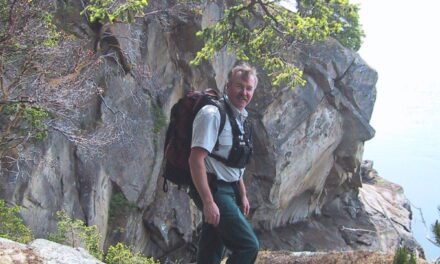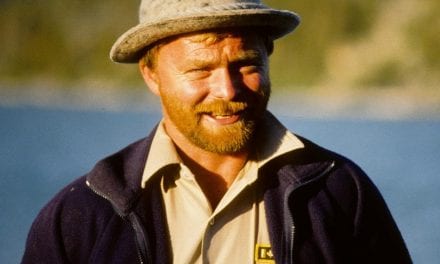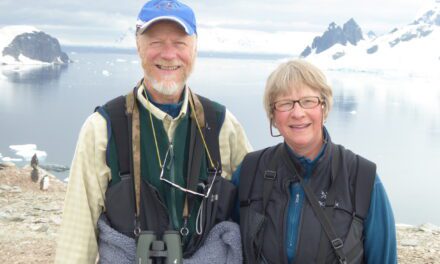I would like to now talk about my involvement in the changes to law enforcement as I think that story fits in here.
3632: As I said before, I was raised in Kimberley, a small mining town, and my grandfather came here as an engineer and a specialist, had the family and my father grew up here. He was an early environmentalist and he was also a strong union person who nurtured my ideas about unions. My mother was also very important in helping me learn about unions. My mother was part of the first strike that the Hudson’s Bay company ever had from its employees, a group of women in Kimberley. They fought for workers’ rights in wages and I can remember as a young person going to elementary school and then going to the picket line at lunch. Those were things that really impacted me as a child and I was a strong believer of unionism. That was in contrast with many people who ended up in National Parks. And so, as I progressed through the Warden Service I saw some injustices and the one injustice that I saw and that I thought was really important was that of pay equity and recognition for Public Safety wardens. I got involved with the union (Public Service Alliance of Canada) as a result. We couldn’t get life insurance as Park Wardens because we did so many dangerous things. I had life insurance through my university almamater but many of the people could not buy life insurance because we slung under helicopters, we did avalanche control, we dealt with wildlife, we did all these high-risk things. There were accidents where Park Wardens were injured and killed and there was no compensation. I became interested in pursuing a way to help. There were other sorts of injustices and I was reminded of it by John Wackerle when he said to me, “You helped me with that Union stuff.” And so I began working to help. After many presentations and much work on behalf of the wardens for them to be reclassified, we were just not recognized and it was very frustrating. Because of the system of hierarchy and classification within the government as a whole, managers were stymied. As an aside to that, when we became an agency we were promised that as the reclassification was reworked from the CEO down to the Superintendents, we would be finally recognized. Management was reclassified, their pay was increased but it was stopped at them. We never got the classification we were entitled to in my opinion.
40:35 Going back to Law Enforcement, throughout the 1990s, there were 4 contracted independent studies of National Park Wardens and what they did in Law Enforcement and in each of those studies, the recommendation was that Park Wardens be armed and trained appropriately as Law Enforcement Officers. And we pushed the element. We tried doing it the logical way through studies into the situation, and the last one of those studies was from the BC Justice Institute. They went to management and said, “Look you are putting your Park Wardens in danger by not training and equipping them to be a professional Law Enforcement entity.” They still did not listen. Finally, we held a meeting in Victoria between the management and union to discuss the issue once and for all. All of the top brass from Parks were there as well as the Union. Everyone agreed at the meeting that Park Wardens were to be armed. Darro Stinson was the spokesperson of the meeting and would present it to the hierarchy of park. Throughout this meeting Tom Lee, the Assistant Deputy Minister and Gaby Fortin were completely aware of our recommendations As Darro flew across the country to make his presentation to Parks, the bosses at Parks Canada decided they would not arm Park Wardens. The Union then decided to hold a meeting in Canmore to decide what we should do. We invited Park Wardens, Management, Gaby Fortin the Director and then we invited Labour Canada to come in and discuss where we were going to go and how we could fix this transgression of putting people at risk of doing the job they were required to do without the proper equipment and training. One thing that happened at the meeting that I will never forget was a comment made by Gaby as he said during one of the discussions. “Well you could use a rock or a shovel to defend yourself if you really needed to”. An unbelievable comment to be made by a manager who clearly did not give a shit about the safety of Park Wardens –unbelievable. At the end of the meeting, a fellow by the name of Bob Grundie, who was the Labour Officer who gave the presentation, said, “Well in order to change the elements, you are going to have to put in a complaint.” So I, being the union guy, put in the safety labour complaint in June of 2000. The complaint was assigned to Bob Grundie by the management of Labour Canada and that started the whole process and it was quite an amazing process. Some people in Parks Canada thought there was a conspiracy between Bob and myself but before meeting him in Canmore I did not know him. This whole issue created a huge division within the Warden Service.
There were those people who supported the idea of professionalizing it and those who were against it. And I received a lot of hate mail and a lot of support mail in both directions. It was fascinating for me to work within that realm. We had hearings, the way the rules of that day occurred and we went all the way up to a fellow named Cadeau- an adjudication officer. The union hired a labour lawyer by the name of Andrew Ravin. We brought in expert witnesses to support the aspect of arming. More politics ensued. At first, we had the support from the RCMP experts but that support dried up because of Government pressure. I remember one “use of force” expert whom we had obtained and we flew him to Ottawa and he was going to present at the hearing. He got a phone call driving from the airport in Ottawa to the hotel, and he was threatened with his job. I told our lawyer, and we couldn’t jeopardize his career by putting him on the stand so we ended up having to eliminate him. And it was all the way through. All of these people whom Bob Grundie had talked to prior, were so supportive of us, but then it came down that they could not, for fear of retaliation, support us. We had to look for other experts. I was able to get a special agent from FBI agency from Quantico, USA. He was a Law Enforcement Behavioral Science Specialist (PHD) by the name of Ed Davis and the FBI paid for him to come to Canada and be a witness for us on the stand. He had dealt with Wildlife Enforcement agencies throughout the US – National Park Rangers and Forest Service and States agencies and the use of force and the training that they required. And we had people such as Chris Butler who was an expert for the Calgary City Police come in and they became witnesses for us because we couldn’t use our normal channels due to the degree of threat. The witnesses Parks Canada put on the stand were in my opinion a total embarrassment as they seemed unknowledgeable about the issue. So it went through and the first hearing was fascinating.
The hearing officer Cadeau ruled against us. We were shocked. We found out through my union connections, that a fellow was at a meeting with Cadeau when Sheila Copps, the Minister at the time, came into that meeting and told him how he was going to rule, because she (and the Liberals in general) were opposed to the Park Wardens being armed. They didn’t want that arming aspect to overflow to Border Guards or Canadian Wildlife Service Officers. This fellow at the meeting wanted to be able to come forward with this information but could not because he did not have whistle blower legislation to protect him. So that ruling of Cadeau was being forced by the political entities of the day. We had to appeal it to Federal Court so we brought in all these experts into Federal Court once again and the Cadeau ruling was overturned and the head of that Federal Court hearing was Marshall Rothstien who ended up being put on the Supreme Court of Canada by Harper. Rothstien ordered a new hearing . That was at the transition between the Liberals and the Conservatives, when the Harper Government came into power.
The next hearing date was with Doug Malenca and we ended up being supported on that aspect of it. It wasn’t just a Liberal issue as the Conservatives were opposed to Park Wardens being armed as well. Through the President of the PSAC Union I met with Minister Baird, the Minister in charge of Parks and gave a presentation to him about arming the Park Wardens and why we needed it. Alan Latourelle, the CEO of Parks, was at that meeting as well. It was amazing how politics got involved and came down to all levels. It was very divisive because many people thought that the gun issue was the spear that broke the Warden Service but it had been in the works for a long long time. Many people in management in the National Parks were against what they called the Green Machine, and wanting to dismantle the power of the Warden Service.
The arming issue did change the Warden Service drastically, but it professionalized it and possibly saved lives. They are now trained to the full police officer level and protect that landscape in an enforcement element, another tool of protection of National Parks along with the aspects of Public Safety and Resource Management. (That took a lot of wind out of my sails to think about that again). It was quite a tumultuous period for me. It started in the 1990s with the 4 separate studies ending in the Victoria meeting with the British Columbia Justice Institute final recommendation. Each of those 4 private contractor studies recommended to management that they professionalize the Warden Service law enforcement in the training, in essence arming as we were federal officers. Parks ignored all of these recommendations. Ironically when I first started in 1974 as a warden, Earl Skjonsberg, another character and John Wackerle, still had .38 revolvers that they had been issued as side arms as a Park Warden for the purpose of protecting themselves from wildlife and from “bad guys”. Earl said, “I always carried a .38 on me unless I forgot it”.
This brings me to memories of old Park Wardens like Earl and Johnny Wackerle. When we were out in the backcountry, they poured out cans of beans or cans of stew into a pot and that’s what we had for dinner. I said to Earl, “We have got to do something differently.” The first time I cooked Earl a cake at Barrier, he was absolutely blown away. He said, “I’m never cooking again, you’re cooking.” Thinking of more cooking stories I am tired of talking about the gun issue. One time at Indianhead, I had stored a frozen roast in the oat bin and came back 8 days later to have a roast with Duane Martin. So I took the roast out of the oat bin and cut off the green bits but he wouldn’t eat any of it. For a while he’d worked in a funeral home, and he said, “I’ve embalmed pieces of meat that smelled better than that!” and he would not eat it. I loved it, it was great! Well aged.
The gun issue was quite tumultuous and it made me very ill at the end. I was off on sick leave at the end of my career and saw doctors to get back my health. It was pretty traumatic but I think in the long run, it improved and professionalized the Warden Service and I would do it again. I am very disappointed at how all levels management and individuals attacked those of us who were involved – thank god for the union. They tried to destroy Bob Grundie, Mark MacIntyre and Duane Martin. Bob and Duane were in essence fired but the Union got their jobs back with compensation pay. Mark got a job with Canadian Wildlife Service. It was a seventeen-year process. It officially began in 1991-2007. I guess it is still going on. It was a big thing how Chief Park Wardens and Regional Directors, management in general, attacked us and took us out. I remember having discussions with Gaby Fortin and he said, “What’s the big deal? So we lose a few big horn sheep or a couple of grizzly bears, we’ve got lots of them.” I have a hard time, even to this day, to comprehend that thought process. I believe that no person should be allowed to poach a big horn sheep or a grizzly bear from a National Park. We may not have been able to catch all of them but we have to have the deterrent out there, and the deterrent was large enough with imprisonment and fines, that it definitely put us at risk. I’ve been shot at on the boundary and threatened…by myself at Shale Pass and having a hunter say, “I could shoot you and leave you here.” And having that sort of discussion going on or crawling on the ground in Waterton where people had shot at me, and bullets hitting the ground around me, and me going, “Holy crap, where am I going to go and what am I going to do? I can’t dig into this fence line anymore”. And even to the point of having an erratic truck driving on the eastbound lane of the TransCanada highway near Sunshine, and pulling him over with my red and blues and the individual came out of the truck with a piece of steel in his hands and chased me backwards down the highway. He was on drugs of some sort and had been driving for a very long period of time and was under some sort of stress and lost it. And threatening me, and all I had was my vehicle. So I literally went screaming back in a reverse direction to get away from this guy who was nuts, and later the RCMP picked him up. The fight to arm Park Wardens was the right thing to do but it was a very long process. I am very disappointed in the lack of support but the managers were threatened with their livelihood I guess as well as us. But it is not an excuse for how they acted or what they did to people. At my retirement I was given a rock on a plaque reminding me of the Canmore meeting. I hope the above explanation clarifies why I became involved in the Warden gun issue and I want to thank those people who helped over the many years.
.
MH: What about the Warden Service was important to you? 5800:
DM: I strongly believe in the protection and preservation of that land (parks) being set aside for future generations and to be left unimpaired. And we won’t see the total value of that until cities like Calgary reach 5 million. We’re almost there so it is even more important now. The land is so valuable for recreation and preservation.
MH: Are there any legendary characters or stories associated with the Warden Service that you can share? 5840:
DM: Hundreds of stories. Tim Auger and his compassion. The liberal arts thinker turned climber. I think I’ve mentioned a few others.
MH: Is there anyone from the Service that stands out in your mind? 5900:
DM: Earl Skjonsberg, John Wackerle, Tim Auger, Keith Everts. And people like Duane Martin. He believed in professionalizing the Law Enforcement aspect. People like Andy Anderson and Bob Haney. Bob was a Chief Park Warden whom I have a great deal of respect for. He was always so calm. I remember he and I sat down and talked about the whole gun issue and he said, “This is going to be very tumultuous.” And he believed in it and supported me but was very cautionary. Common sense Bob Haney. That’s what I always thought about him.
One of the other characters was from Canmore, the photographer, Bruno Engler. I was a forecaster at Norquay and he was 65 years old and working as a Seasonal Park Warden. I had lots of fun with Bruno. He worked on Avalanche Control at Mt. Norquay, Keith Everts had hired him, and he was a winter seasonal term Warden and had done this several different times over the years. He was collecting a wage, collecting Old Age Security and at that time he had a child, so was collecting a Baby Bonus!

Doug Martin at Norquay photo by Bruno Engler 1982




Kudos on the Doug Martin interview. A lifetime of living. Thank you to the Alumi.